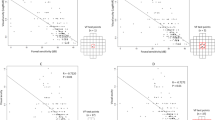Abstract
Purpose
The purpose of this study was to estimate the optimal size of visual field test for detecting longitudinal changes in retinitis pigmentosa (RP) by dividing the visual field.
Methods
We reviewed the results of 10° static visual field tests in 19 eyes of 19 RP patients. Sixty-eight numeric value points were divided into two area types: concentric areas (A1, A1–2, A1–3, A1–4, A1–5, A1–6) and circular areas (A1, A2, A3, A4, A5, A6). Serial values of mean sensitivity in each area of each patient were analyzed by linear regression.
Results
Analysis of the concentric areas showed that 10 of 19 eyes had the best R 2 value in the most central area, A1. Analysis of circular areas showed that 7 of 19 eyes had the steepest slope of decline in A1. The inner-segment/outer-segment (IS/OS) line was significantly shorter in eyes with low variability and evident disease progression in the inner areas than the ones in the outer areas.
Conclusions
The optimal size of monitoring RP progression was different in each case and may depend on the remaining morphology of the outer retina.




Similar content being viewed by others
References
Hartong DT, Berson EL, Dryja TP. Retinitis pigmentosa. Lancet. 2006;368:1795–809.
Kim LS, McAnany JJ, Alexander KR, Fishman GA. Intersession repeatability of Humphrey perimetry measurements in patients with retinitis pigmentosa. Invest Ophthalmol Vis Sci. 2007;48:4720–4.
Hirakawa H, Iijima H, Gohdo T, Imai M, Tsukahara S. Progression of defects in the central 10-degree visual field of patients with retinitis pigmentosa and choroideremia. Am J Ophthalmol. 1999;127:436–42.
Felius J, Thompson DA, Khan NW, Bingham EL, Jamison JA, Kemp JA, et al. Clinical course and visual function in a family with mutations in the RPE65 gene. Arch Ophthalmol. 2002;120:55–61.
Hood DC, Ramachandran R, Holopigian K, Lazow M, Birch DG, Greenstein VC. Method for deriving visual field boundaries from OCT scans of patients with retinitis pigmentosa. Biomed Opt Express. 2011;2:1106–14.
Abe K, Iijima H, Hirakawa H, Tsukahara Y, Toda Y. Visual acuity and 10 degrees automated static perimetry in eyes with retinitis pigmentosa. Jpn J Ophthalmol. 2002;46:581–5.
Nakazawa M, Ohguro H, Takeuchi K, Miyagawa Y, Ito T, Metoki T. Effect of nilvadipine on central visual field in retinitis pigmentosa: a 30-month clinical trial. Ophthalmologica. 2011;225:120–6.
Berson EL, Rosner B, Sandberg MA, Weigel-DiFranco C, Brockhurst RJ, Hayes KC, et al. Clinical trial of lutein in patients with retinitis pigmentosa receiving vitamin A. Arch Ophthalmol. 2010;128:403–11.
Berson EL, Rosner B, Sandberg MA, Weigel-DiFranco C, Moser A, Brockhurst RJ, et al. Clinical trial of docosahexaenoic acid in patients with retinitis pigmentosa receiving vitamin A treatment. Arch Ophthalmol. 2004;122:1297–305.
Fujimoto N. Comparison of a five-degree visual field between two programs of different testing field range. Am J Ophthalmol. 2007;143:866–7.
Duggan C, Sommer A, Auer C, Burkhard K. Automated differential threshold perimetry for detecting glaucomatous visual field loss. Am J Ophthalmol. 1985;100:420–3.
Sommer A, Duggan C, Auer C, Abbey H. Analytic approaches to the interpretation of automated threshold perimetric data for the diagnosis of early glaucoma. Trans Am Ophthalmol Soc. 1985;83:250–67.
Suzuki Y, Araie M, Ohashi Y. Sectorization of the central 30 degrees visual field in glaucoma. Ophthalmology. 1993;100:69–75.
Wirtschafter JD, Becker WL, Howe JB, Younge BR. Glaucoma visual field analysis by computed profile of nerve fiber function in optic disc sectors. Ophthalmology. 1982;89:255–67.
Iijima H. Correlation between visual sensitivity loss and years affected for eyes with retinitis pigmentosa. Jpn J Ophthalmol. 2012;56:224–9.
Spry PG, Johnson CA. Identification of progressive glaucomatous visual field loss. Surv Ophthalmol. 2002;47:158–73.
Heijl A, Bengtsson B. The effect of perimetric experience in patients with glaucoma. Arch Ophthalmol. 1996;114:19–22.
Rangaswamy NV, Patel HM, Locke KG, Hood DC, Birch DG. A comparison of visual field sensitivity to photoreceptor thickness in retinitis pigmentosa. Invest Ophthalmol Vis Sci. 2010;51:4213–9.
Author information
Authors and Affiliations
Corresponding author
About this article
Cite this article
Ogino, K., Otani, A., Oishi, A. et al. Concentric division of 10° visual field tests in retinitis pigmentosa. Jpn J Ophthalmol 57, 268–274 (2013). https://doi.org/10.1007/s10384-013-0235-y
Received:
Accepted:
Published:
Issue Date:
DOI: https://doi.org/10.1007/s10384-013-0235-y




